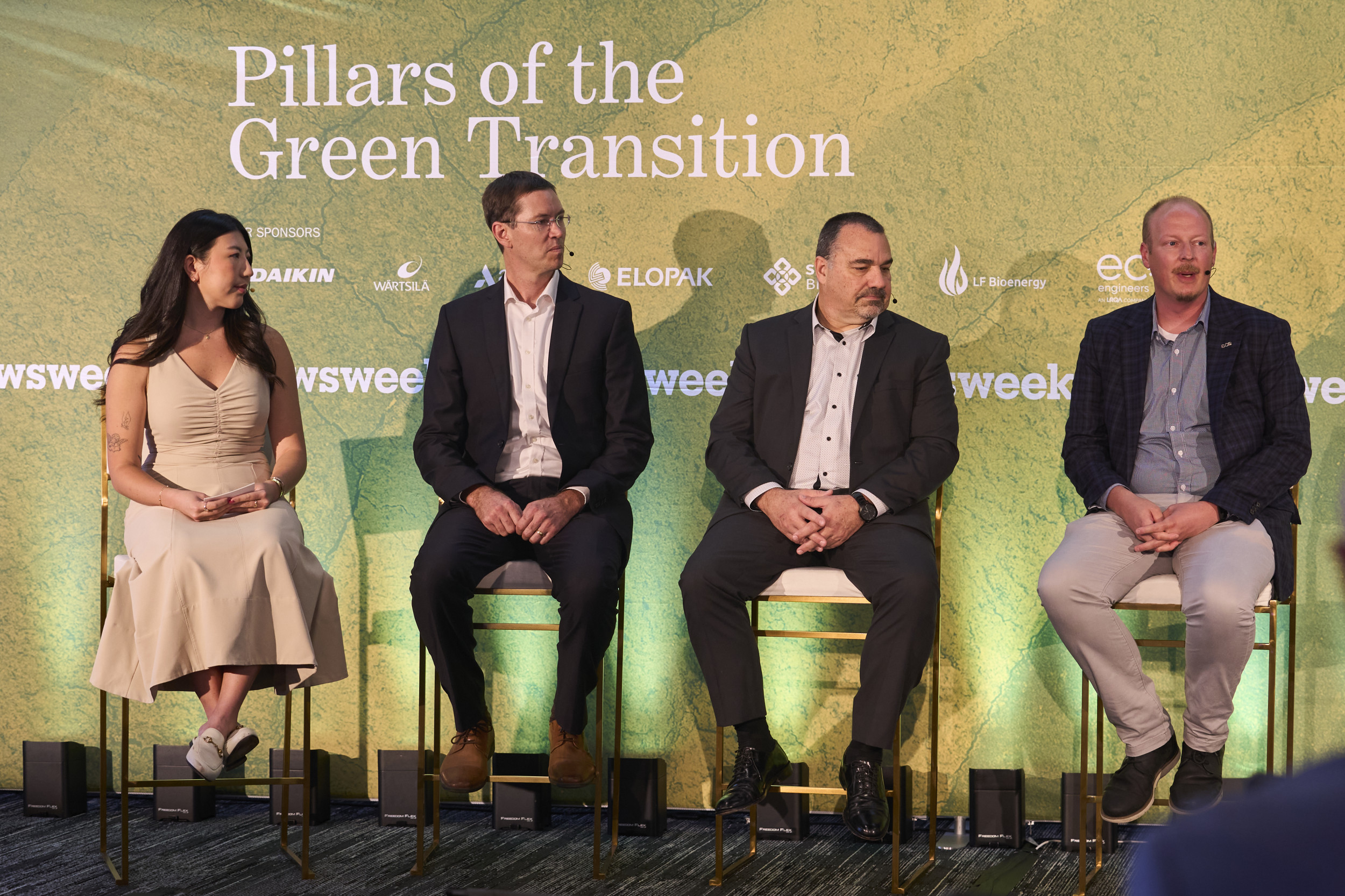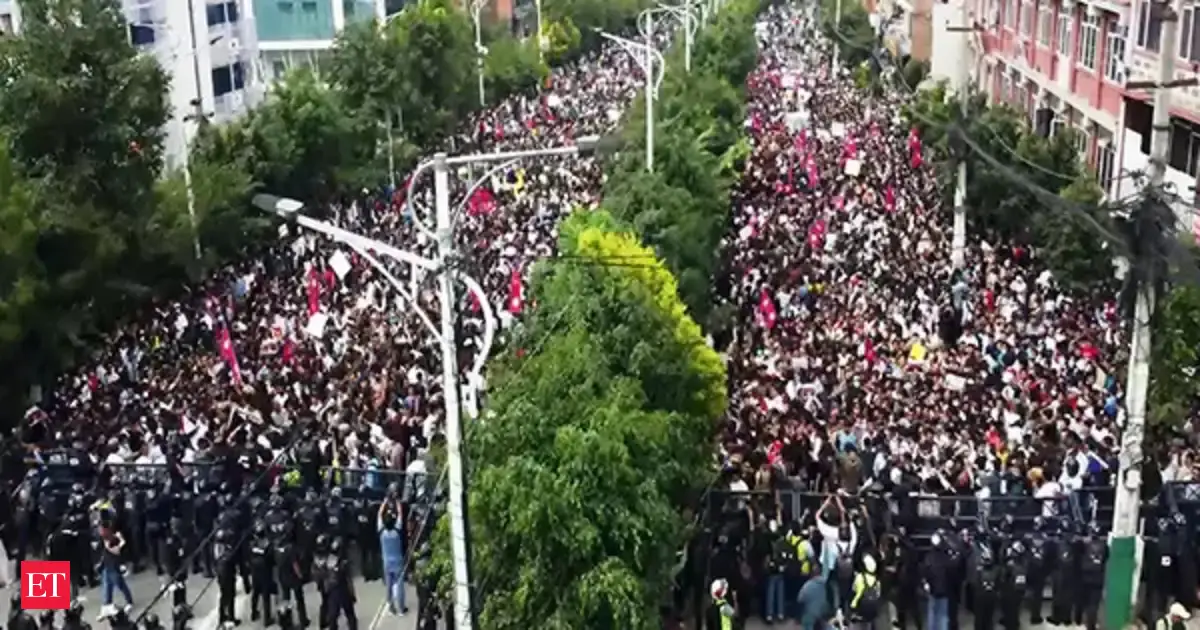
Energy demands around the world are rising, and with the increasing impacts of climate change and the declining efficiency of existing infrastructure, the situation is likely to worsen.
That was the premise outlined by Newsweek’s Environmental and Sustainability Editor Jeffery Young during the “Pillars of the Green Transition” conference at Newsweek’s headquarters in New York City on September 24, 2025.
Wednesday brought together industry leaders to discuss investing in sustainable strategies that help meet their climate goals. Panels focused on energy storage and improved grid resilience, sustainability in food systems and how bioenergy is becoming the cornerstone of decarbonization.
The event comes during Climate Week NYC, a week when world leaders and environmental activists gather to talk about sustainability goals amid the United Nations General Assembly meeting.
This year also marks the tenth anniversary of the 2015 Paris Climate Agreement, an international agreement aimed at limiting greenhouse gas emissions to curb increasing global temperatures at 1.5 degrees Celsius above preindustrial levels.
Discussions of sustainability goals and decarbonization policy feel particularly pressing, as the Trump administration has rolled back several climate actions of the last four years.
Early in the day, Young’s comment about the spike in energy demand kicked off the “Expanding Possibilities with Energy Storage” panel.
Evan van Hook, the chief sustainability officer at Viridi, said there will be a 70 percent increase in energy demand by 2050.
“What’s even more scary to me is that there will be a 50 percent increase in peak demand,” he said. “That means those peaks that we’re barely able to meet now will get a lot higher.”
This daunting reality means finding alternative solutions is imperative.
Panelists throughout the day shared how the innovations in their respective fields are making a difference to reduce carbon and other greenhouse gas emissions and transition farmers and energy grids to renewable sources, all while improving efficiency and minimizing costs.
A driving theme of the conference was that there is no one solution to solving the climate crisis. Instead, it will require many small changes across industries to meet the most ambitious sustainability goals.
As Wärtsilä president and CEO Håkan Agnevall said during the same panel, “green is not black and white.”
“There is no single, simple solution, so storage is only one of the solutions that we need to build a sustainable future and an affordable future,” he said.
While energy storage will greatly improve energy grid capabilities, Agnevall said this option is “not the holy grail that will solve all our problems in the power system.”
Batteries are one of the many tools that can build and strengthen resiliency and enable the transition to renewables.
The opportunities for improvements in energy storage exemplify what new, innovative technology can do to deliver practical benefits to everyone.
“It’s the world’s biggest machine, the electric grid,” Jeffery Young said in his closing remarks.” And yet it is always operated in this just in time, delivered to the nanosecond. That’s nuts for such an important thing that we depend on for life saving services, critical services.”
The ability to store that energy and deliver it when demand is high is “a game changer,” Young said. This will allow communities around the world to use more renewable energy and reduce the peak demand, which he said is a threat to both sustainability and reliability.
Unfortunately, the green transition cannot occur from technological advances alone; It will require systematic changes to infrastructures, regulations and consumer habits.
Our food systems are a major contributor to greenhouse gas emissions and pollution around the world – from growing to packaging, distribution and disposal.
“The consumption of plastics is overwhelming right now,” Elopak CEO Thomas Körmendi said during the “Growing Climate Solutions in Food System” panel. And sustainable packaging has between 35 to 70 percent lower carbon emissions than plastic packaging because of changes to reusability, transportation and production.
Regenerative agriculture, or sustainable farming, is another key to building resiliency and lowering emission impact. Phil Harris, chief revenue officer at Avra, noted the practices his company is teaching farmers to mitigate climate impact and ensure these farms will continue to thrive and produce for decades to come.
He acknowledged that “it’s not a good time to be a farmer in the U.S.” and said the transition to regenerative farming will take time but the benefits are worthwhile.
“Farmers know how to do things in a sustainable way, but they’re up against these cost barriers,” he said. “Farmers are great CEOs, they run very good businesses, they’re very savvy and smart.”
Alex Gillett, the CEO of HowGood, said the science required to make this transition is already known, but the work comes with implementing those changes at scale across the complex and diverse supply chains and food system.
He said CEOs he works with see prices skyrocketing along their supply chains, but also understands that “if they don’t make the changes that are necessary, that will only accelerate.”
This not only requires funding for farming but also government intervention.
“What we need to do is institute the things that help drive the change,” he said. “That’s government policy [and] a blended finance approach to be able to bring in the change at scale that we need.”
But Körmendi noted that implementation and regulation can be challenging for multinational companies when those policies vary across countries and states.
On the consumer side, convincing someone to make the switch to a more environmentally friendly product or habit is not always easy. People don’t often like change, and they especially don’t like it when that change comes with a higher price tag.
Helen Clarkson, the CEO of Climate Group, a Newsweek partner and the organization responsible for putting on Climate Week, said consumers really care about convenience, price taste and health when they choose their foods, followed by health with sustainability much further down the priority list.
Diet influencers on social media and even government organizations have historically been effective in directing how consumers should eat. But during the “Growing Climate Solutions in Food Systems” panel, Clarkson said environmentalists need to do a better job of communicating sustainability.
“It hasn’t worked on climate to think that consumers will come and save us, but if you help people, they will make good choices, but often through other lenses,” she said. “It’s about being sophisticated about what the story is there.”
She said there needs to be a better way to promote the narrative that healthy diets overlap with being good for the environment and help people make those decisions.
Even with packaging, she said, simply labeling a product as environmentally friendly is not enough to get someone to make a different, more sustainable choice.
Gillett added that data shows people want to take better care of the world, but they don’t understand what different terms and labels mean.
“Go to the eggs aisle and look at how many certifications [on the cartons], cage free, free range, certified, humane, USDA, organic,” he said. “It’s a nightmare because they’re labeled similarly and people don’t understand [which] one of those is better than the other. We have a NASCAR of certifications and claims within our grocery store, and we don’t know how to help people find what matches with their values.”
He said their project aimed at simplifying the marketing saw an average 230 percent lift in sales for the best products.
“People care what the regulations are, how we communicate, or how we don’t communicate influences [them],” he said. “We have such distance from our food system that we need to design a data and communication system that brings the emotionality of what’s really happening to the person at the point of their purchase.”
Cost is a major factor for all consumers. During the “Turning Emissions into Energy: Bioenergy at the Core of the Green Transition” panel, EcoEngineers CEO Brad Pleima addressed this issue head-on.
For him, comparing fossil fuels with renewable natural gas is not like comparing apples to oranges; it’s more like comparing Starbucks to coffee made at home.
A cup of Keurig at your house might cost a quarter per pod, but that’s not the same as going to Starbucks to get an eight-dollar iced espresso.
“They’re different products, and they both are coffee and they’re both good and they both have their place and there’s times where I just want to make coffee at my house,” he said. “But there’s times I want Starbucks too. It’s convenient, it’s quality of ingredients, it’s really what goes into that. It makes it expensive, but there’s benefits of value to that.”
Looking ahead, leaders in sustainability industries need to pitch environmentalism as a smart, common-sense business choice.
“I don’t care where you fall, what side of the fence you fall on regarding climate change, I look at it from an efficiency perspective,” LF Bioenergy CEO Brent Lilienthal said. “We have a waste stream that can produce energy. It helps safeguard our food supply and, at the same time, it helps, whether you’re an environmentalist or not, it does help the environment.”
He said leaders need to take out the rhetoric and the debate and look at the issue pragmatically to help consumers understand how these changes align with their mission and goals. This industry has grown significantly, he said, because the changes “make common sense.”
Brad Pleima agreed, saying that the opportunity to move towards sustainability can span politics.
He said environmentalists are typically aligned with a certain political party, but those policies build revenue streams, build rural infrastructure, create rural jobs, decarbonize the planet and provide returns for investors.
“Where’s the loss in any of that?” he said. “You can span whatever political beliefs spectrum. If a farmer doesn’t believe that climate change isn’t there, let’s use the revenue side of things, that’s going to shore up that generational aspect of farming.”
Climate-conscious solutions are a “win-win” for everyone, he said, so leaders in these industries need to focus more on how to tell that story so it appeals to consumers regardless of their thoughts on climate change.
“Whatever your political beliefs, these are just good projects, good opportunities,” he said.



